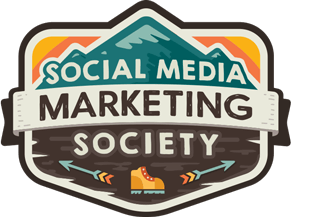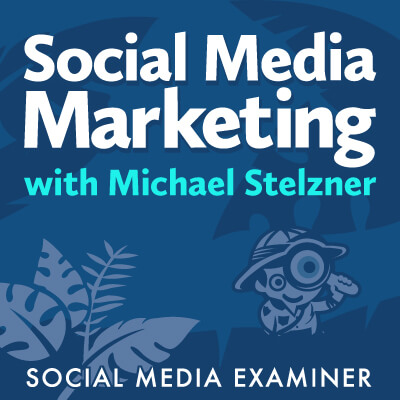Wondering how to divide your time between marketing your agency and serving clients? Looking for advice from someone who’s figured it out?
In this article, you’ll discover how to allocate agency resources for ongoing content marketing, client qualification, service development, and more.

Balancing Marketing and Sales Efforts for Agency Growth
Running a successful business requires effectively balancing efforts between critical functions like marketing and sales. Marketing technology expert John Wall shares strategies for optimizing time allocation between these crucial areas based on business stage, metrics, feedback, and more.
#1: Getting Started: Focus Equally on Your Marketing and Sales Efforts
John recommends the book Traction: How Any Startup Can Achieve Explosive Customer Growth by Gabriel Weinberg and Justin Wares for small business owners who haven't yet achieved product-market fit. The traction framework dedicates 50% of your effort to improving your product itself while spending the other 50% on sales and marketing efforts to get market feedback. This intense focus is required early on to validate that customers want your product and will pay for it—that they understand the value of your product.
As your business grows and you build capabilities in different functions like paid advertising or content marketing, you can start to focus and specialize around what is working well. Traction recommends starting with just three key marketing tactics as a solo founder. As you scale, you add dedicated people to specific channels that generate results, like paid ads. John says each channel within your business becomes its own mini-business focused on return on investment.
Also, your content marketing should align with your sales team's needs. Valuable content educates your potential customers about your company and your products and services. What matters most is sales and marketing working closely together, not which team owns content creation. As long as the content creator gets feedback from sales and gives them valuable materials, the structure doesn't matter.
Start with what prospects are searching for—testimonials, product demos, etc. Then, move up the funnel to more educational, awareness-building content. If your content doesn't somehow inch deals forward and drive revenue, you need to adjust, John says. Everything should tie back to your pipeline and cash flow. Who owns it matters less than whether it sells.
For companies under $20 million, achieving market-product fit can feel a bit like surfing—constantly adjusting and redirecting resources. John compares uncertainty to riding a tiger: “You're riding a tiger, and everybody thinks that, ‘Oh my God, that's so cool. You're riding a tiger.’ And the reality is you're on the tiger saying, ‘Oh my God, how did I end up on this tiger?’”
Gated vs Ungated Content
Whether to gate content behind registration comes down to business objectives: Top-of-funnel educational content should be ungated to maximize reach, John says. You want that spreading far and wide.
But further down the funnel, use gating for materials targeting qualified leads. If you have entry-level, mid-level, and premium offers, gate a specific piece of content around each to capture leads by their willingness to pay.
Ungated content reaches 12X more people typically. So, use that for broad awareness. Use gating to identify warmer leads from their content interests.
This tiered, context-specific strategy to gating balances lead gen with open sharing for exposure. You get volume top-funnel and qualification further down.
The Importance of Regular Reviews
Rather than reactively amping up marketing or sales during a quarterly shortfall, John recommends building a quarterly review cadence, enabling your business to adjust allocations proactively based on results. Assessing metrics around website traffic, email click-throughs, churn, and more can show you what to double down on.
For example, you know that churn is problematic for agencies. But if one of your clients doesn't renew their contract, it likely means you could have demonstrated more value. You have to figure out if you didn't deliver what you promised or if you did but didn't produce the expected results.
Get World-Class Marketing Training — All Year Long!
Are you facing doubt, uncertainty, or overwhelm? The Social Media Marketing Society can help.
Each month, you’ll receive training from trusted marketing experts, covering everything from AI to organic social marketing. When you join, you’ll also get immediate access to:
- A library of 100+ marketing trainings
- A community of like-minded marketers
- Monthly online community meetups
- Relevant news and trends updates
It's an ongoing balancing act, but a good rule of thumb is for the agency owner to spend half their time on sales and marketing initially. As you grow, the goal is to specialize so you avoid constantly feeling overwhelmed trying to do everything.
#2: Key Metrics and Key Performance Indicators to Guide Your Marketing/Sales Split
Rather than reactively changing the sales and marketing mix when results dip, proactively start from the end goal and work backward. John recommends tracking a few key metrics:
- Net Promoter Score—feedback from existing happy customers on what they value. Why do your existing customers like your business and products or services?
- Win Rate—what marketing channels and content were most influential for closed deals?
- Sales Qualified Leads to Marketing Qualified Leads ratio—conversion rates from marketing to sales. What percentage of leads did your sales team like and pursue? If you have limited data, you can tally up the leads to determine the most promising lead generation activities to scale up.
- Customer Annual Value (CAV)—yearly profitability of customers. Instead of identifying customer lifetime value (CLV), which requires a lot of data and customers to calculate accurately, CAV helps early-stage businesses make decisions without needing the full lifetime view. You can deduct your fixed expenses to estimate potential profit and use that to guide customer acquisition spending. If you know your CAV, you know investing up to perhaps 80% of that to land each new customer will pay off over time.
With account-based marketing (ABM), John notes that the lifetime value of winning one big customer often justifies significant spending on personalized outreach.
For example, if a potential customer brings you $250K annually, flying out to them or taking them to an upscale restaurant to close the deal makes sense. ABM is about qualifying accounts quickly to see if there's an opportunity. Unlike broad marketing, ABM isn't about saving pennies per touchpoint but investing upfront to land whales. The math works even if you only close a small fraction of accounts if their lifetime value is high enough.
These indicators of what’s working can inform optimal time investments into marketing tactics or sales follow-ups. For example, if a particular trade show delivers promising leads each year, it may warrant more ad spend and sales attention. The goal is to base future decisions on which marketing drives the profitable customers your sales force wants.
John is a partner and head of business development at Trust Insights, a marketing analytics consulting firm specializing in data analysis, insights, marketing data science, and machine learning.
At Trust Insights, John and the team are still figuring out their optimal marketing and sales mix. A lot is organic for them—speaking engagements, content sharing, word-of-mouth. So it's not as simple as dollars in, revenue out.
They track and improve on components like:
- Website—is it driving traffic and conversions?
- Email/text lists—do they communicate regularly and deliver value?
- Sales outreach—real-time customer feedback to guide next steps
John says that spending an hour a week or touching each area daily keeps things alive. It ensures forward progress vs being blindsided by declines.
#3: Maximize Efficiency in Marketing/Sales and Focus on Customer Needs
As an agency, you must be defensive and respond to proven customer demand rather than guessing what might work. Get clarity on what your customers will pay for, have a budget for, and when they need it. That allows you to maximize efficiency, John says.

Discover Proven Marketing Strategies and Tips
Want to go even deeper with your marketing? Check out the Social Media Marketing Podcast! Publishing weekly since 2012, the Social Media Marketing Podcast helps you navigate the constantly changing marketing jungle, with expert interviews from marketing pros.
But don’t let the name fool you. This show is about a lot more than just social media marketing. With over 600 episodes and millions of downloads each year, this show has been a trusted source for marketers for well over a decade.
First, check in regularly on what has sold and how customers felt about it. That feedback fuels your product development cycle for services. Next, scale new offerings slowly at first. Float ideas by your best five customers and offer deep discounts in exchange for feedback. See if there’s demand before investing entirely. You can also run ads for not-yet-released services to gauge interest, driving traffic to an email signup landing page. After two months, if an idea got zero clicks, scrap it. If there are 50 clicks, keep developing it.
Both internally-generated and customer-suggested offerings can be misleading if you jump ahead before validating demand. You must test to ensure a service solves a common vs edge case problem. The key is continuously checking in with sales results and customer reactions rather than relying on assumptions.
Customer feedback should also directly shape where you allocate resources across your marketing plan, sales process, and products and services.
Machine learning can help digest large volumes of feedback to surface key themes across your entire organization. For example, if 60% of call driver complaints are around 5 issues, you now know addressing those in self-help content will hugely reduce support costs.
Without structure, you risk bias toward only the squeakiest wheels. Big customers may dominate, while small customers mentioning the same needs get ignored.
Ideally, you have enough statistical data for artificial intelligence (AI) to remove individual noise and reveal meaningful patterns across your customer base. But lacking that, the next best option is balancing gut feel with some framework around which feedback gets priority.
#4: Leverage Predictive Modeling and AI
Especially when working with larger volumes of customer data from surveys or transactional systems, predictive modeling and AI tools can automatically surface patterns around preferences, common issues, churn risk factors, lifetime value, and more.
These insights can rapidly inform content creation, new product development initiatives, account-based sales and marketing campaigns, and other critical investments of your time and money.
While generative AI is revolutionary, John says it has some key caveats. First, it just scans the web, so it can surface nonsense or misinformation from less credible sources. Second, it provides the statistically most probable answer, which is not necessarily correct. Think of it as getting you 70% of the way there.
For agencies, the opportunity is transforming grunt work. AI can generate content ideas, outlines, and even initial drafts. So junior staff productivity leaps ahead. However, some agencies are already seeing clients push back on pricing since AI is assisting, so the expectations game is changing fast.
John predicts that long-term AI may allow agencies to be 30–40% more efficient by automating rote tasks. But for now, it's vital to understand AI's limitations despite the hype. Guide it and validate its work rather than treating its output as gospel.
It’s important to note that putting client data into public AI tools can raise legal, ethical, and privacy concerns. No generic solutions yet exist to leverage AI securely with sensitive data.
Running predictive models privately does require more upfront work, however. You need someone who can code models in Python, for example, and set up the infrastructure. Some high-end laptops, like MacBook Pros, can run specific algorithms locally.
There are differing difficulty levels with setup and maintenance, too. You also need a strategy for when publicly available models get discontinued unexpectedly—plan how to switch models instead of relying on just one.
Trust Insights provides consulting to help companies figure out AI readiness across these considerations—what models apply for what use cases, how to scale usage through APIs vs manual prompts, how to future-proof implementations rather than betting on a specific model's longevity, and more.
John says it's still the Wild West in this space, so having advisory help avoids costly pitfalls.
#5: The Future of Marketing and Sales
Looking ahead, John admits that you can't fully control maintaining a balance between your marketing and sales departments—the best approach is agile adaptation:
- Make the best plans, then review and adjust quarterly/annually based on results.
- Accept you can execute flawlessly and still fail due to external factors.
- Control what you can, mainly consistent systems for decision-making.
- Build resilience amidst uncertainty by blazing your trail vschasing someone else's.
Long-term success depends on disciplined iteration, not mindlessly following “guaranteed” methods. If you check assumptions and change course as needed, you give yourself the best odds through business cycles and the tendency toward chaos.
John Wall speaks, writes, and practices at the intersection of marketing, sales, and technology. He's partner and head of business development at Trust Insights. He’s held positions specializing in Customer Relationship Management, Marketing Automation, and sales support systems, working with clients like Amazon, Salesforce, Microsoft, and Oracle. John’s the producer and co-host of the Marketing Over Coffee podcast and author of B2B Marketing Confessions and The Marketing Over Coffee Playbook. You can find him on Trust Insights’s Analytics for Marketers group.
Brooke B. Sellas is host of the Marketing Agency Show, a Social Media Examiner production. She is founder and CEO of B Squared Media, an agency that helps people connect, converse, and convert on social media. Her book is called Conversations That Connect. Find her on X/Twitter and LinkedIn.
Listen to the Podcast Now
This article is sourced from the Marketing Agency Show. Listen or subscribe below.
Where to subscribe: Apple Podcasts | Spotify | YouTube Music | YouTube | Amazon Music | RSS
✋🏽 If you enjoyed this episode of the Marketing Agency Show, please head over to Apple Podcasts, leave a rating, write a review, and subscribe.
Stay Up-to-Date: Get New Marketing Articles Delivered to You!
Don't miss out on upcoming social media marketing insights and strategies! Sign up to receive notifications when we publish new articles on Social Media Examiner. Our expertly crafted content will help you stay ahead of the curve and drive results for your business. Click the link below to sign up now and receive our annual report!
Attention Agency Owners, Brand Marketers, and Consultants

Introducing the Marketing Agency Show–our newest podcast designed to explore the struggles of agency marketers.
Join show host and agency owner, Brooke Sellas, as she interviews agency marketers and digs deep into their biggest challenges. Explore topics like navigating rough economic times, leveraging AI, service diversification, client acquisition, and much more.
Just pull up your favorite podcast app, search for Marketing Agency Show and start listening. Or click the button below for more information.

